Thermal Comfort and Green Spaces: The Role of Temperature-Regulating Elements in Neighborhood Parks
Abstract
1. Introduction
- The balance between the density of impervious surfaces and the density of green spaces has either a positive or negative impact on thermal comfort levels in neighborhood parks.
- The selection of different plant species can significantly alter the thermal comfort levels within neighborhood parks.
- The distribution of plants can influence thermal stress levels, thereby enhancing users’ comfort within neighborhood parks.
2. Materials and Methods
2.1. Materials
2.2. Climate
2.3. Methods
2.4. Statistical Analysis
3. Results
The Effect of the Presence of Planted Green Spaces in Parks on Thermal Comfort
4. Discussion
5. Conclusions
Author Contributions
Funding
Institutional Review Board Statement
Informed Consent Statement
Data Availability Statement
Acknowledgments
Conflicts of Interest
References
- Wu, J.; Hou, Z.; Shen, J.; Lian, Z. Quantitative effect on work performance considering interactions among multiple indoor environmental factors. Build. Environ. 2020, 185, 107286. [Google Scholar] [CrossRef]
- Xu, X.; Lan, L.; Shen, J.; Sun, Y.; Lian, Z. Five hypotheses concerned with bedroom environment and sleep quality: A questionnaire survey in Shanghai city, China. Build. Environ. 2021, 205, 108252. [Google Scholar] [CrossRef]
- Du, H.; Lian, Z.; Lai, D.; Duanmu, L.; Zhai, Y.; Cao, B.; Hou, Z. Comparison of thermal comfort between radiant and convective systems using field test data from the Chinese Thermal Comfort Database. Build. Environ. 2022, 209, 108685. [Google Scholar] [CrossRef]
- Liu, C.; Tang, L.; Yan, J.; Ouyang, J. Direct and indirect effects of multisensory modalities on visitor’s thermal comfort in an urban park in a humid-hot climate. Int. J. Sustain. Dev. World Ecol. 2023, 30, 319–328. [Google Scholar] [CrossRef]
- Cheng, C.Y.; Lin, T.P. Decision Tree Analysis of Thermal Comfort in the Courtyard of a Senior Residence in Hot and Humid Climate. Sustain. Cities Soc. 2024, 101, 105165. [Google Scholar] [CrossRef]
- Toksoy, M. Isıl Konfor; TMMOB Makine Mühendisleri Odası Bildiriler Kitabı: Ankara, Türkiye, 1993. [Google Scholar]
- Santamorius, M. Energy and Climate in the Urban Built Environment; James & James: London, UK, 2011. [Google Scholar]
- Yeang, K. Ekotasarım: Ekolojik Tasarım Rehberi; YEM Yayın: İstanbul, Türkiye, 2012. [Google Scholar]
- Altunkasa, C. Use of Outdoor Microclimate Maps in Design with Climate: A Case Study of Çukurova University Faculty of Architecture. Master’s Thesis, Çukurova University Institute of Natural and Applied Sciences, Department of Landscape Architecture, Adana, Türkiye, 2020. [Google Scholar]
- Özcan, U. Günümüz Mimarisinde Kullanılan HVAC Sistemleri, Mimariyle olan ilişkileri ve Hıgh Tech Yapılarda Uygulama Örnekleri. Ph.D. Thesis, Haliç Üniversitesi, İstanbul, Türkiye, 2008. [Google Scholar]
- Eres, B. Turizm Yapılarında Hvac Sistemlerin Isıl Konfor ve İç Hava Kalitesi Bakımından Kullanıcı Sağlığı ile İlişkisinin İncelenmesi. Master’s Thesis, Fatih Sultan Mehmet Vakıf Üniversitesi, İstanbul, Türkiye, 2019. [Google Scholar]
- UN Revision of World Urbanization Prospects. Available online: https://www.un.org/development/desa/en/news/population/2018-revision-of-world-urbanization-prospects.html (accessed on 20 July 2024).
- IPCC. Assessment Report 6-WGI Report. IPCC. 2021. Available online: https://www.ipcc.ch/report/ar6/wg1/downloads/report/IPCC_AR6_WGI_FullReport.pdf (accessed on 28 October 2024).
- 2021 Joins Top 7 Warmest Years on Record: WMO. Available online: https://news.un.org/en/story/2022/01/1110022 (accessed on 21 January 2022).
- Demircan, M.; Gürkan, H.; Eskioğlu, O.; Arabaci, H.; Coşkun, M. Climate Change Projections for Turkey: Three Models and Two Scenarios. Turk. J. Water Sci. Manag. 2017, 1, 22–43. [Google Scholar] [CrossRef]
- Bağçaci, S.Ç.; Yücel, İ.; Düzenli, E.; Yılmaz, M.T. Intercomparison of the expected change in the temperature and the precipitation retrieved from CMIP6 and CMIP5 climate projections: A Mediterranean hot spot case, Turkey. Atmos. Res. 2021, 256, 105576. [Google Scholar] [CrossRef]
- Climate Change Knowledge Portal. Available online: https://climateknowledgeportal.worldbank.org/country/test-country/trends-variability-projections (accessed on 20 July 2024).
- Cohen, M. Habitat II and the Challenge of the Urban Environment: Bringing together the two Definitions of Habitat. Int. Soc. Sci. J. 1996, 48, 95–101. [Google Scholar] [CrossRef]
- Gangloff, D. The Sustainable City. Am. For. 1996, 101, 30–36. [Google Scholar]
- Willis, K.G.; Turner, R.K.; Bateman, I.J. Urban Planning and Management; Edward Elgar Publishing: New York, NY, USA, 2001. [Google Scholar]
- Tosun, E.K. Sürdürülebilirlik Olgusu Ve Kentsel Yapiya Etkileri. Parad. Ekon. Sosyol. Ve Polit. Derg. 2009, 14. [Google Scholar]
- Tozam, İ.; Bulut Karaca, Ü. Kentsel Isı Adası Etkisi ve Serin Çatılar, 9. Ulusal Çatı & Cephe Konferansı, (pp.35-46). İstanbul, Turkey. 2018. Available online: https://www.b2bmedya.com/ekitap/pdf/9uncu-ulusal-cati-ve-cephe-konferansi-bildiriler-kitabi-2018.pdf (accessed on 20 July 2024).
- Chen, L.; Mak, C.M.; Hang, J.; Dai, Y. Influence of elevated walkways on outdoor thermal comfort in hot-humid climates based on on-site measurement and CFD modeling. Sustain. Cities Soc. 2024, 100, 105048. [Google Scholar] [CrossRef]
- Climate Central. Available online: https://www.climatecentral.org/climate-matters/urban-heat-islands-2023 (accessed on 20 July 2024).
- Allegrini, J.; Dorer, V.; Carmeliet, J. Influence of the urban microclimate in street canyons on the energy demand for space cooling and heating of buildings. Energy Build. 2012, 55, 823–832. [Google Scholar] [CrossRef]
- Boeri, A.; Gaspari, J. A multi-layer approach to urban re generation: Energy efficiency and comfort condition optimization. TECHNE-J. Technol. Archit. Environ. 2015, 10, 214–221. [Google Scholar] [CrossRef]
- Algeciras, J.A.R.; Coch, H.; Pérez, G.; Yeras, M.C.; Matzarakis, A. Human thermal comfort conditions and urban planning in hot-humid climates—The case of Cuba. Int. J. Biometeorol. 2016, 60, 1151–1164. [Google Scholar] [CrossRef]
- Demir, A.Ö.; Cengiz, C. Ilıman-Nemli İklim Bölgelerinde Kentsel Alanlarda Biyoklimatik. Avrupa Bilim Ve Teknol. Derg. 2021, 32, 1134–1139. [Google Scholar] [CrossRef]
- Balogun, I.A.; Daramola, M.T. The outdoor thermal comfort assessment of different urban configurations within Akure City, Nigeria. Urban. Clim. 2019, 29, 100489. [Google Scholar] [CrossRef]
- Chen, L.; Ng, E. Outdoor thermal comfort and outdoor activities: A review of research in the past decade. Cities 2012, 29, 118–125. [Google Scholar] [CrossRef]
- Amani Beni, M.; Khalilnezhad, M.R.; Shen, Z.W. Iranian citizens’ behaviors and attitudes on visitations and appreciation of the urban green space during the COVID-19 epidemic. Acta Hortic. 2023, 1374, 85–92. [Google Scholar] [CrossRef]
- Khalilnezhad, M.R.; Amani Beni, M.; Shen, Z.W. Accessibility, visibility and connectivity between urbanites and edible landscape in the Persian gardens. Acta Hortic. 2023, 1374, 109–116. [Google Scholar] [CrossRef]
- Dehghanifarsani, L.; Khalilnezhad, M.R.; Amani Beni, M. Book Review: Prominski et al. River. Space. Design. Planning Strategies, Methods and Projects for Urban Rivers, 3rd and Enlarged ed.; Birkhäuser: Basel, Switzerland. Land 2023, 12, 1483. [Google Scholar] [CrossRef]
- Dong, J.; Guo, R.; Lin, M.; Guo, F.; Zheng, X. Multi-objective optimization of green roof spatial layout in high-density urban areas—A case study of Xiamen Island, China. Sustain. Cities Soc. 2024, 115, 105–827. [Google Scholar] [CrossRef]
- Guo, R.; Guo, F.; Dong, J.; Wang, Z.; Zheng, R.; Zhang, H. Finer-scale urban health risk assessment based on the interaction perspective of thermal radiation, human, activity, and space. Front. Archit. Res. 2024, 13, 682–697. [Google Scholar] [CrossRef]
- The Sixth Assessment Report (AR6) of the United Nations (UN) Intergovernmental Panel on Climate Change (IPCC). (IPCC 6. Assesment/Cross-Chapter Paper 4: Mediterranean Region). Available online: https://www.ipcc.ch/report/ar6/wg2/downloads/report/IPCC_AR6_WGII_SOD_CCP4.pdf (accessed on 19 March 2024).
- Google earth 9.3.105.0. Görükle, Turkey. 40°13′41″N, 28°50′38″E, DigitalGlobe 2024. Available online: https://earth.google.com/web/ (accessed on 28 October 2024).
- Korukçu, A.; Yazgan, S.; Gündoğdu, K. Bursa ve yöresinde Su Kaynaklarına İlişkin Sorunlar; Marmara Bölgesinde Tarımın Verimlilik Sorunları Sempozyumu: Bursa, Türkiye, 1989. [Google Scholar]
- Sefa, S. Bilecik, Bursa, Kütahya Yöresi Kuru ve Sulanabilir Şartlarda Kuru Soğanın Azotlu ve Fosforlu Gübre İsteği ile Olsen Fosfor Analiz Metodu’nun Kalibrasyonu; Eskişehir Bölge Topraksu Araştırma Enstitüsü Müdürlüğü Yayınları: Eskişehir, Türkiye, 1983. [Google Scholar]
- UI GreenMetric World University Rankings: Background of The Ranking. Available online: https://greenmetric.ui.ac.id/about/welcome (accessed on 20 July 2024).
- Meteoblue Weather. Available online: https://www.meteoblue.com/tr/hava/historyclimate/climatemodelled/g%c3%b6r%c3%bckle_t%c3%bcrkiye_746552 (accessed on 20 July 2024).
- Baltacı, A. The qualitative research process: How to conduct a qualitative research? Ahi Evran Univ. J. Soc. Sci. Inst. (AEÜSBED) 2019, 5, 368–388. [Google Scholar]
- Sayad, B.; Alkama, D.; Ahmad, H.; Baili, J.; Aljahdaly, N.H.; Menni, Y. Nature-based solutions to improve the summer thermal comfort outdoors. Case Stud. Therm. Eng. 2021, 28, 101399. [Google Scholar] [CrossRef]
- Gioia, A.; Paolini, L.; Malizia, A.; Oltra-Carrió, R.; Sobrino, J.A. Size matters: Vegetation patch size and surface temperature relationship in foothills cities of northwestern Argentina. Urban. Ecosyst. 2014, 17, 1161–1174. [Google Scholar] [CrossRef]
- Correa, E.; Ruiz, M.A.; Canton, A.; Lesino, G. Thermal comfort in forested urban canyons of low building density. An assessment for the city of Mendoza, Argentina. Build. Environ. 2012, 58, 219–230. [Google Scholar] [CrossRef]
- Hami, A.; Abdi, B.; Zarehaghi, D.; Maulan, S. bin. Assessing the thermal comfort effects of green spaces: A systematic review of methods, parameters, and plants’ attributes. Sustain. Cities Soc. 2019, 49, 101634. [Google Scholar] [CrossRef]
- Matzarakis, A.; Amelung, B. Physiological equivalent temperature as indicator for impacts of climate change on thermal comfort of humans. In Seasonal Forecasts, Climatic Change and Human Health; Springer: Dordrecht, The Netherlands, 2008; pp. 161–172. [Google Scholar]
- Hedquist, B.C.; Brazel, A.J.; Sabatino, S.D.; Carter, W.; Fernando, H.J.S. Phoenix Urban Heat Island Experiment: Micrometeorological Aspects. In Proceedings of the Eighth Conference on the Urban Environment, AMS 89th Annual Meeting, Phoenix, AZ, USA, 12 January 2009. [Google Scholar]
- Höppe, P. Heat balance modelling. Experientia 1993, 49, 741–746. [Google Scholar] [CrossRef]
- Höppe, P. The physiological equivalent temperature -a universal index for the biometeorological assessment of the thermal environment. Int. J. Biomet 1999, 43, 71–75. [Google Scholar] [CrossRef]
- Matzarakis, A.; Mayer, H.; Iziomon, M.G. Applications of a universal thermal index: Physiological equivalent temperature. Int. J. Biometeorol. 1999, 43, 76–84. [Google Scholar] [CrossRef]
- Matzarakis, A.; Rutz, F.; Meyer, H. Estimation and calculation of the mean radiant temperature within urban structures. In Biometeorology and Urban Climatology at the Turn of the Millenium (ed. by R.J. de Dear, J.D.; Kalma, T.R. Oke, and A. Auliciems) Selected Papers from the Conference, Sydney; University of Freiburg: Freiburg, Germany, 2000. [Google Scholar]
- Gulyas, A.; Unger, J.; Matzarakis, A. Evaluation of microclimatic and human comfort conditions in a complex urban environment: Modeling and measurements. Build. Environ. 2006, 41, 1713–1722. [Google Scholar] [CrossRef]
- Fanger, P.O. Thermal Comfort: Analysis and Applications in Environmental Thermal Comfort: Analysis and Applications in Environmental Engineering; Danish Technical Press: Copenhagen, Denmark, 1970. [Google Scholar]
- Matzarakis, A.; Mayer, H. Heat stress in Greece. Int. J. Biometeorol. 1997, 41, 34–39. [Google Scholar] [CrossRef] [PubMed]
- Blazejczyk, K.; Epstein, Y.; Jendritzky, G.; Staiger, H.; Tinz, B. Comparison of UTCI to selected thermal indices. Int. J. Biometeorol. 2012, 56, 515–535. [Google Scholar] [CrossRef] [PubMed]
- Lai, D.; Guo, D.; Hou, Y.; Lin, C.; Chen, Q. Studies of outdoor thermal comfort in northern China. Build. Environ. 2014, 77, 110–118. [Google Scholar] [CrossRef]
- Alfano, F.R.D.A.; Palella, B.I.; Riccio, G. Notes on the calculation of the PMV index by means of apps. Energy Procedia 2016, 101, 249–256. [Google Scholar] [CrossRef]
- Budd, G.M. Wet-bulb globe temperature (WBGT)—Its history and its limitations. J. Sci. Med. Sport. 2008, 11, 20–32. [Google Scholar] [CrossRef]
- Hyatt, O.M.; Lemke, B.; Kjellstrom, T. Regional maps of occupational heat exposure: Past, present, and potential future. Glob. Health Action. 2010, 3, 5715. [Google Scholar] [CrossRef]
- Zare, S.; Hasheminejad, N.; Shirvan, H.; Hemmatjo, R.; Sarebanzadeh, K.; Ahmadi, S. Comparing Universal Thermal Climate Index (UTCI) with selected thermal indices/environmental parameters during 12 months of the year. Weather Clim. Extrem. 2018, 19, 49–57. [Google Scholar] [CrossRef]
- Toy, S.; Yılmaz, S. Peyzaj Tasarımında Biyoklimatik Konfor ve Yaşam Mekanları İçin Önemi. Ank. Üniversitesi Ziraat Fakültesi Derg. 2009, 40, 133–139. [Google Scholar]
- Davis, P.H. Flora of Turkey and the East Aegean Islands; Edinburgh University Press: Edinburgh, Scotland, 1970; Volume 3, p. 645. [Google Scholar]
- Kayacık, H. Orman ve Park Ağaçlarının özel Sistematiği, I. Cilt, Gymnospermae (Açık Tohumlar); İstanbul Üniversitesi Orman Fakültesi Yayınları: İstanbul, Türkiye, 1980. [Google Scholar]
- Kayacık, H. Orman ve Park Ağaçlarının özel Sistematiği, II. Cilt, Angiospermae (Kapalı Tohumlar); İstanbul Üniversitesi Orman Fakültesi Yayınları: İstanbul, Türkiye, 1981. [Google Scholar]
- Kayacık, H. Orman Park ve Ağaçlarının özel Sistematiği, III. Cilt, Angiospermae (Kapalı Tohumlular); İstanbul Üniversitesi Orman Fakültesi Yayınları: İstanbul, Türkiye, 1982. [Google Scholar]
- Yaltırık, F. Bazı Yapraklı Ağaç ve çalıların Kışın Tanınması (Uygulama Kılavuzu); Ormancılık Eğitim ve Kültür Vakfı: İstanbul, Türkiye, 1991. [Google Scholar]
- Dirr, M.A. Manual of Woody Landscape Plants: Their Identification, Ornamental Characteristics, Culture Propagation and Uses; Varsity Press: London, UK, 1992. [Google Scholar]
- Pamay, B. Bitki Materyali I: Ağaçlar ve A0ğaçcıklar; Uycan Matbaası: İstanbul, Türkiye, 1992. [Google Scholar]
- Yaltırık, F. Dendrology Textbook II Angiospermae (Angiosperms); İstanbul University Publication: İstanbul, Türkiye, 1988. [Google Scholar]
- Zencirkıran, M. Determination of native woody landscape plants in Bursa and Uludag. Afr. J. Biotechnol. 2009, 8, 5737–5746. [Google Scholar]
- Ender Altay, E.; Zencirkiran, M. Contributions of native plants to the urban ecosystem: Bursa (Turkey) sample. TeMA-J. Land. Use Mobil. Environ. 2024, 191–204. [Google Scholar]
- IBM Corp. IBM SPSS Statistics for Windows, Version 28.0; IBM Corp.: Armonk, NY, USA, 2017. [Google Scholar]
- Duncan, D.B. Multiple range and multiple F tests. Biometrics 1955, 11, 1–42. [Google Scholar] [CrossRef]
- Lian, Z.; Liu, B.; Brown, R.D. Exploring the suitable assessment method and best performance of human energy budget models for outdoor thermal comfort in hot and humid climate area. Sustain. Cities Soc. 2020, 63, 102–423. [Google Scholar] [CrossRef]
- Liang, C.; Zhang, R.C.; Zeng, J. Optimizing ecological and economic benefits in areas with complex land-use evolution based on spatial subdivisions. Landsc. Urban. Plan. 2023, 236, 104–782. [Google Scholar] [CrossRef]
- Farina, G.; Le Cöent, P.; Neverre, N. Multi-objective optimization of rainwater infiltration infrastructures along an urban–rural gradient. Landsc. Urban. Plan. 2024, 242, 104–949. [Google Scholar] [CrossRef]
- Koçman, A. İzmir'in kentsel gelişimini etkileyen doğal çevre faktörleri ve bunlara ilişkin sorunlar. Coğrafya Araştırmaları Derg. 1991, 3, 101. [Google Scholar]
- Altunkasa, M.F. Adana’da İklimle Dengeli Kentsel Yeşil Alan Planlama İlkelerinin Belirlenmesi ve Çok Amaçlı Bir Yeşil Alan Örneğinde Geliştirilmesi. Çukurova Üniversitesi Ziraat Fakültesi Derg. 1990, 5, 39–54. [Google Scholar]
- Yücekaya, M. Kentsel Açık Mekanların İklimle Dengeli Tasarımına Yönelik Analitik Bir Model Önerisi: Gaziantep Örneği. Ph.D. Thesis, Çukurova Üniversitesi, Adana, Türkiye, 2017. [Google Scholar]
- Olgyay, V. Design with Climate, Bioclimatic Approach to Architectural Regionalism; Princeton University Press: Princeton, NJ, USA, 1973. [Google Scholar]
- Aksu, A.; Yılmaz, S.; Mutlu, B.E.; Yılmaz, H. Ağaçların Bina ile Olan Mesafesinin Dış Mekan Termal Konfor Üzerine Etkisi: Erzurum Kenti Örneği. Iğdır Üniversitesi Fen. Bilim. Enstitüsü Derg. 2020, 10, 1298–1307. [Google Scholar] [CrossRef]
- Elkamhawy, A.; El Eashy, A.; Elfiky, U. Comparative analysis of ten Neighborhood Sustainability Assessment (NSA) tools offering integrated criteria for urban development. Int. J. Sustain. Dev. World Ecol. 2024, 31, 71–88. [Google Scholar] [CrossRef]
- Tzu-Ping, L.; Ting, T.K.; Chieng-Hung, T.; Lung, H.R.; Matzarakis, A. Quantification of the effect of thermal indices and sky view factor on park attendance. Landsc. Urban. Plan. 2012, 107, 137–146. [Google Scholar] [CrossRef]
- Gaspari, J.; Fabri, K. A study on the use of outdoor microclimate map to address design solutions for urban regeneration. Energy Procedia 2017, 111, 500–509. [Google Scholar] [CrossRef]
- Ender, E.; Batman, Z.P.; Şengül, S.; Yıldız, M.C. Kent Meydanları ve Tasarım Süreci: Şanlıurfa Kızılay Meydanı Örneği. Mimar. Ve Yaşam 2022, 7, 853–870. [Google Scholar] [CrossRef]
- Ender Altay, E.; Pirselimoğlu Batman, Z.; Acaray, S. Urban Squares within the Framework of Urban Design: Kadıköy Square, Turkey. Landsc. Archit. Art. 2023, 22, 22. [Google Scholar] [CrossRef]
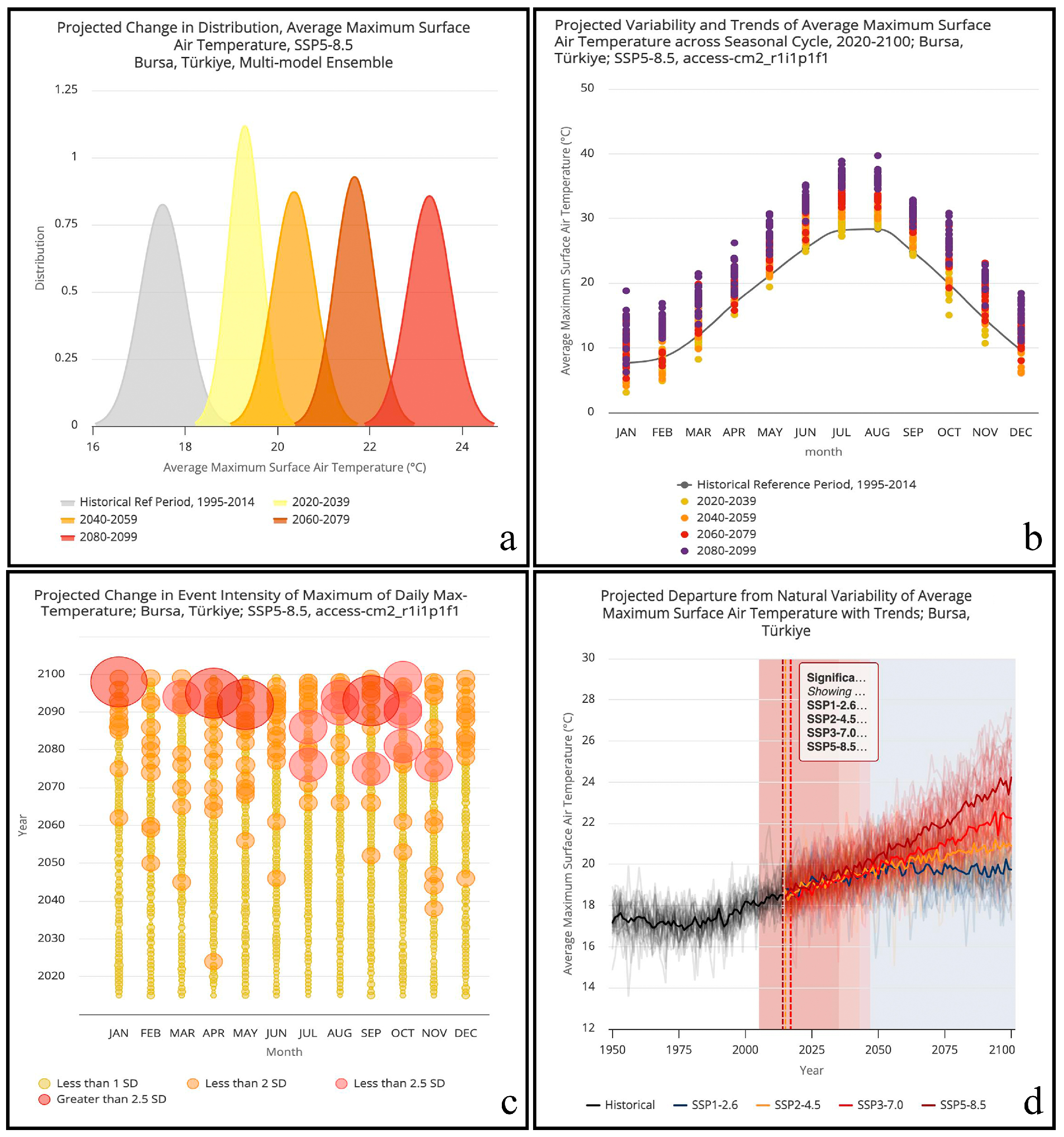

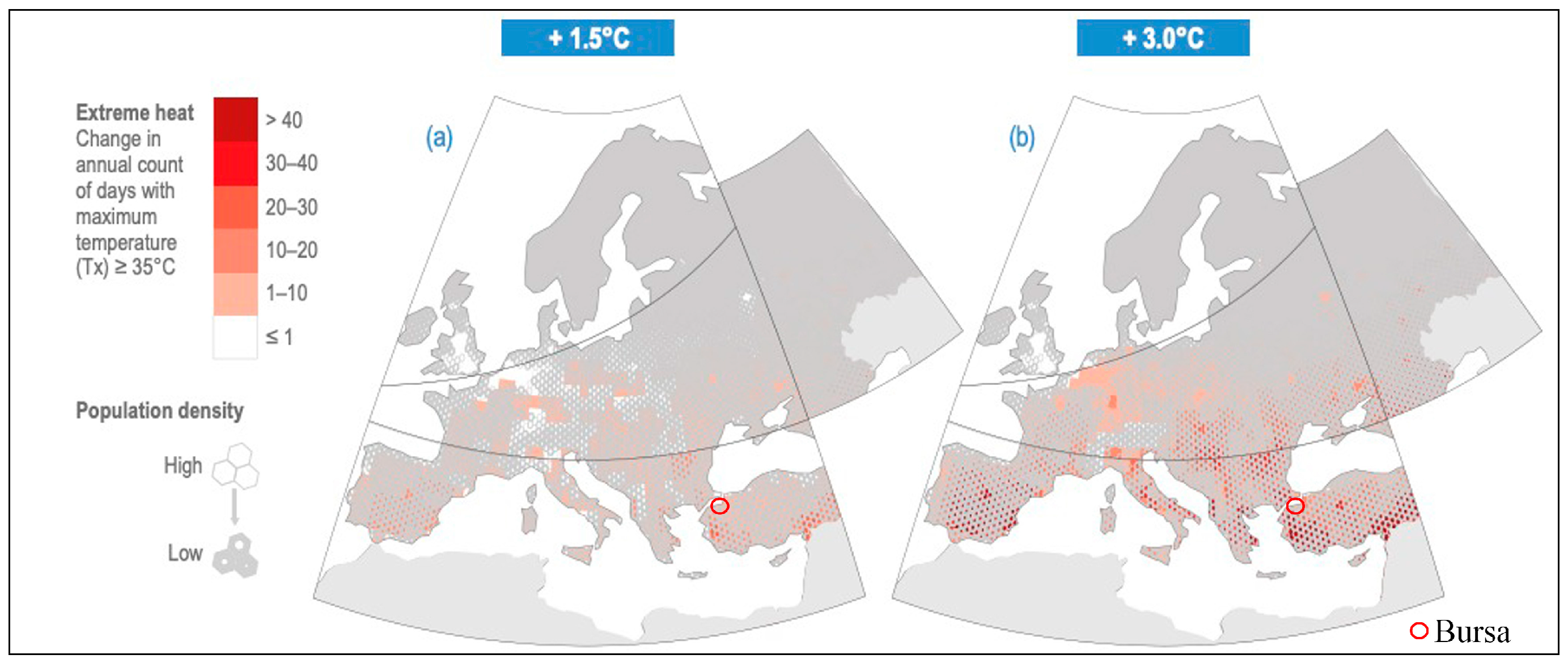
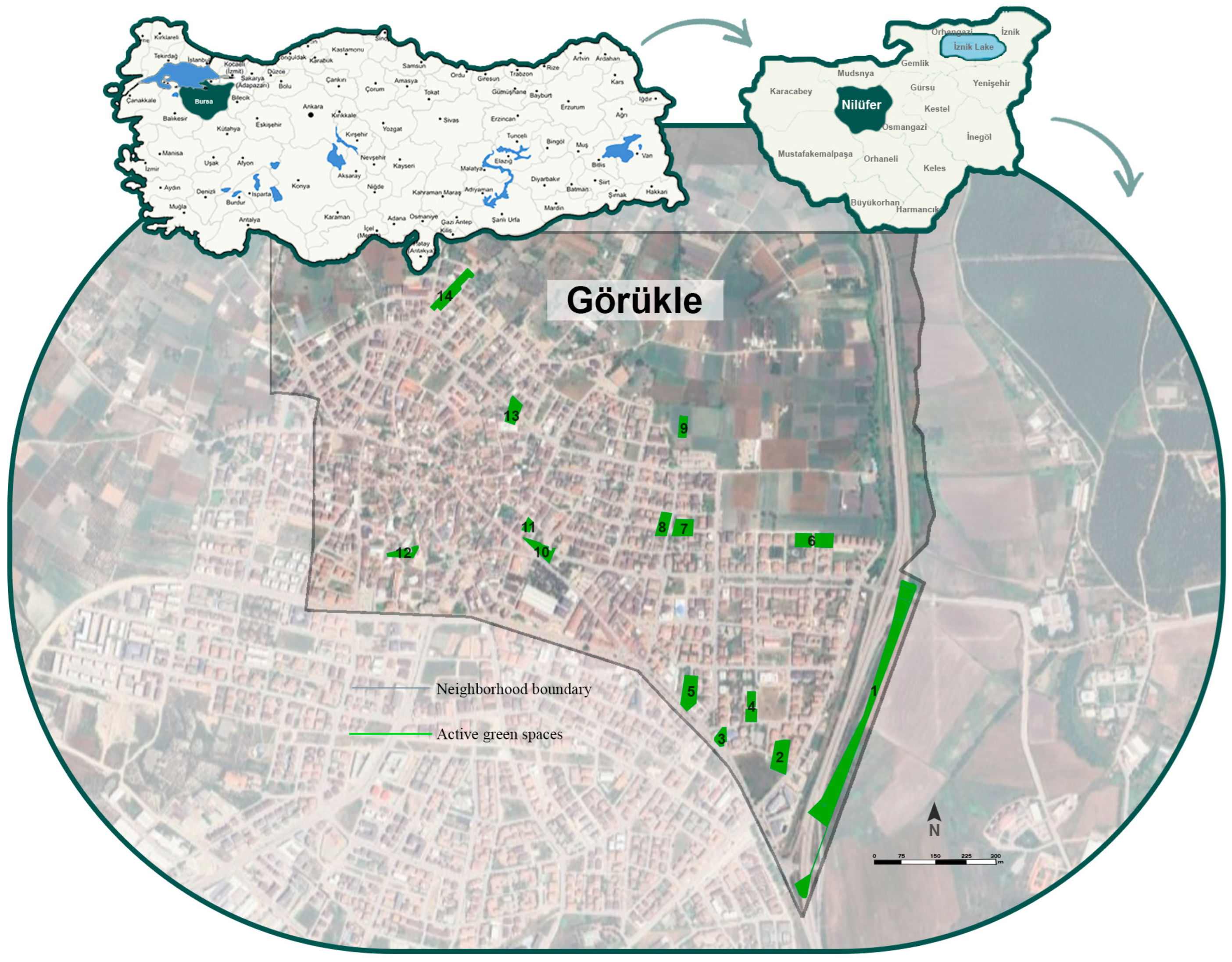
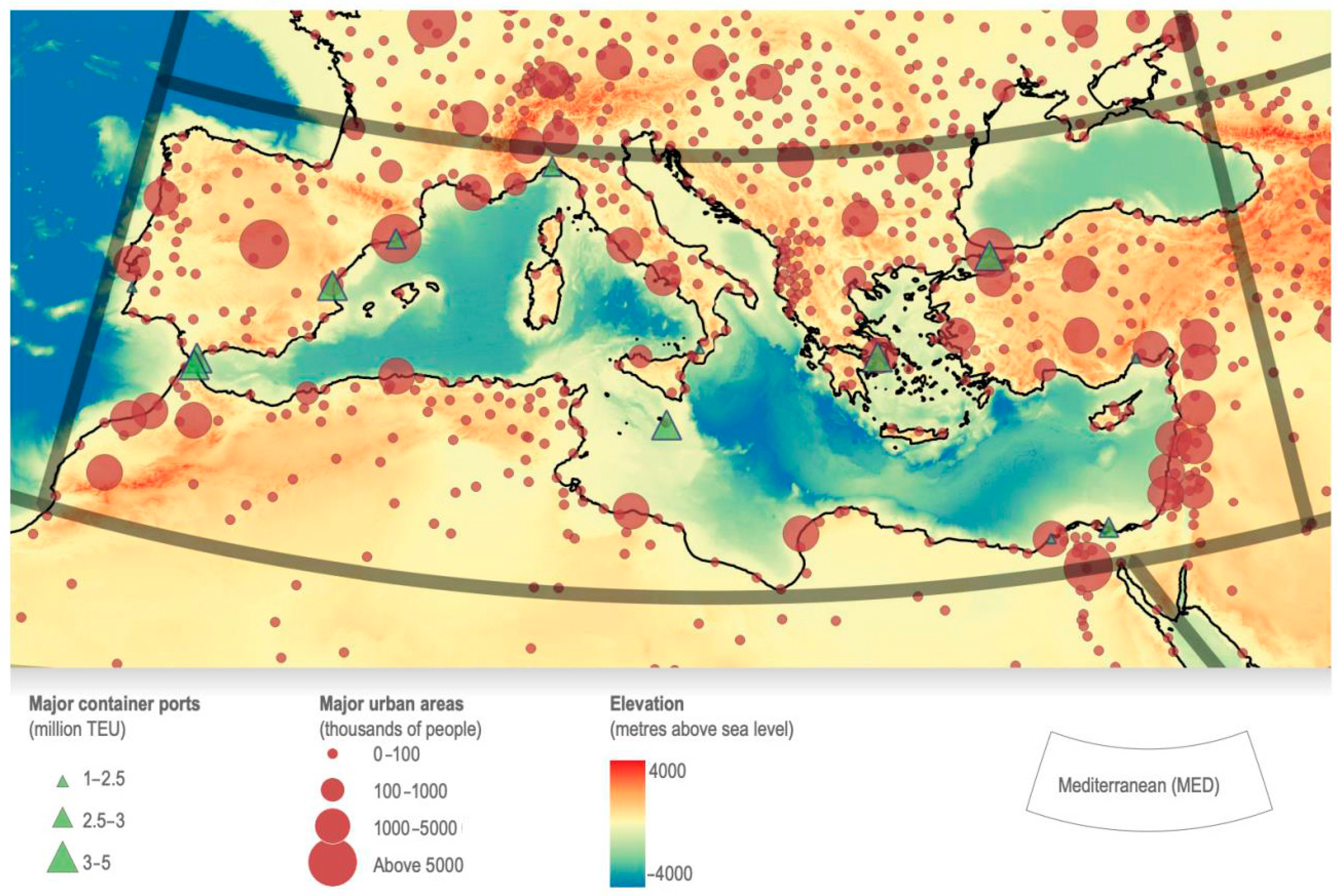

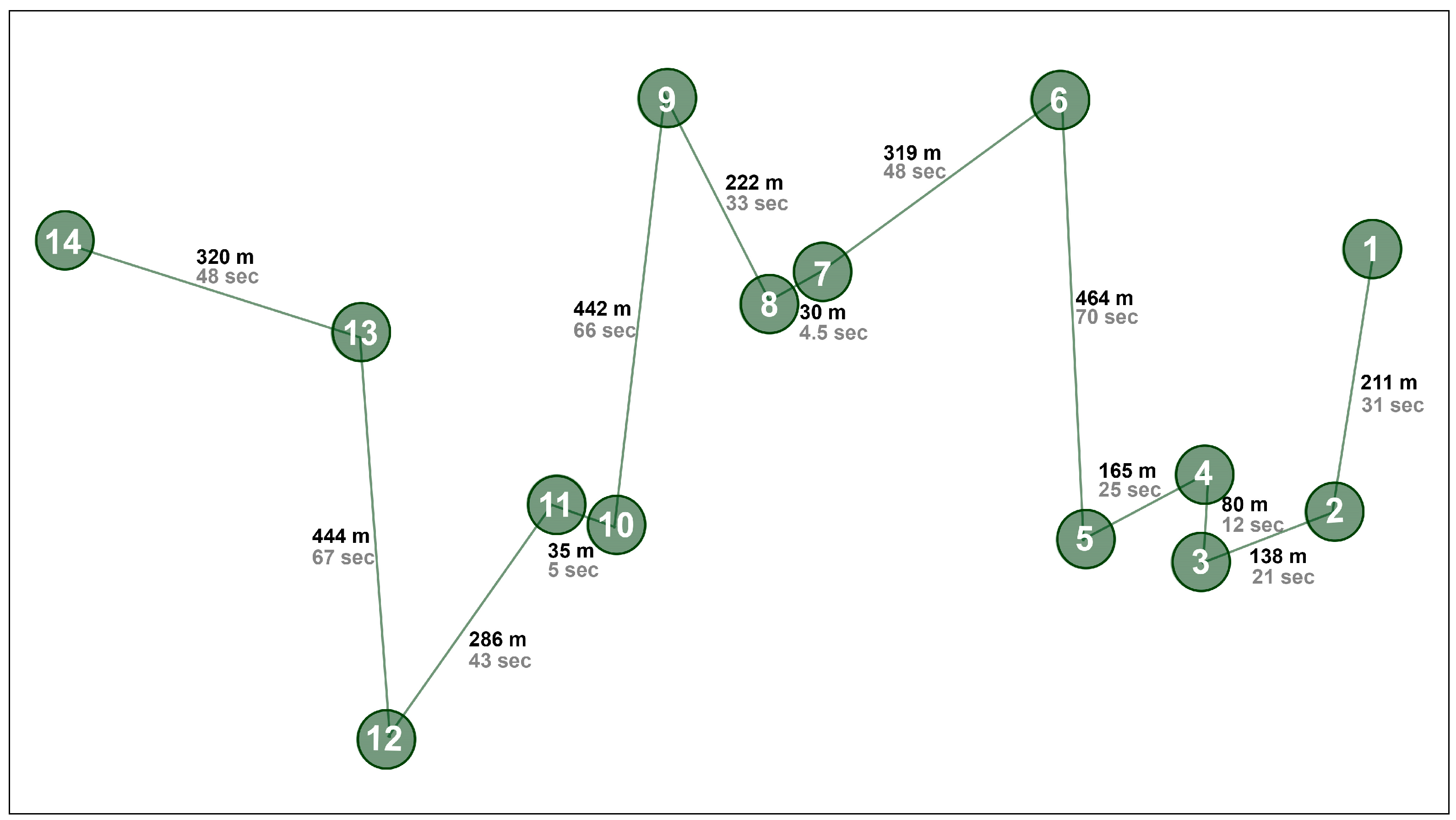
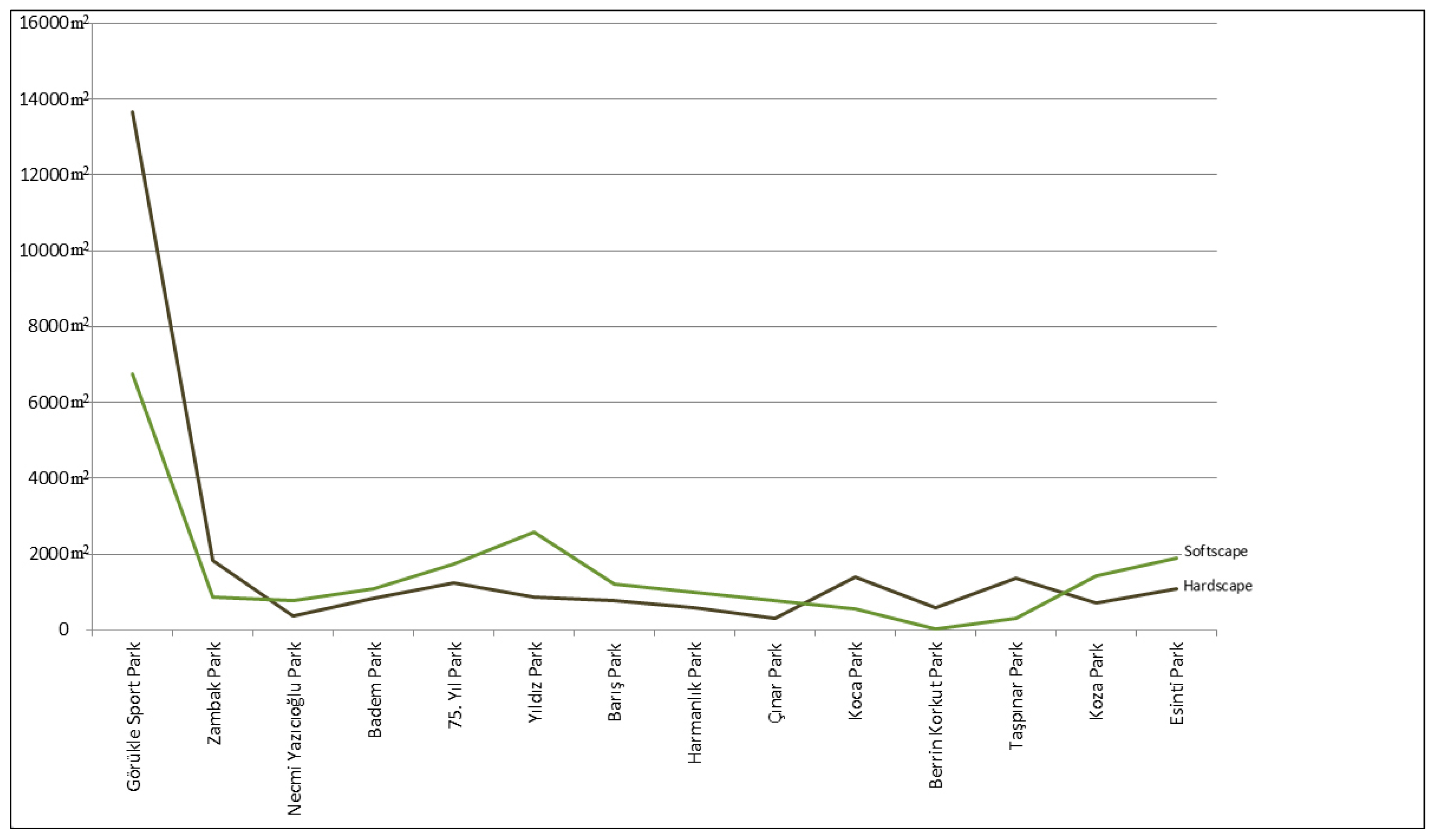
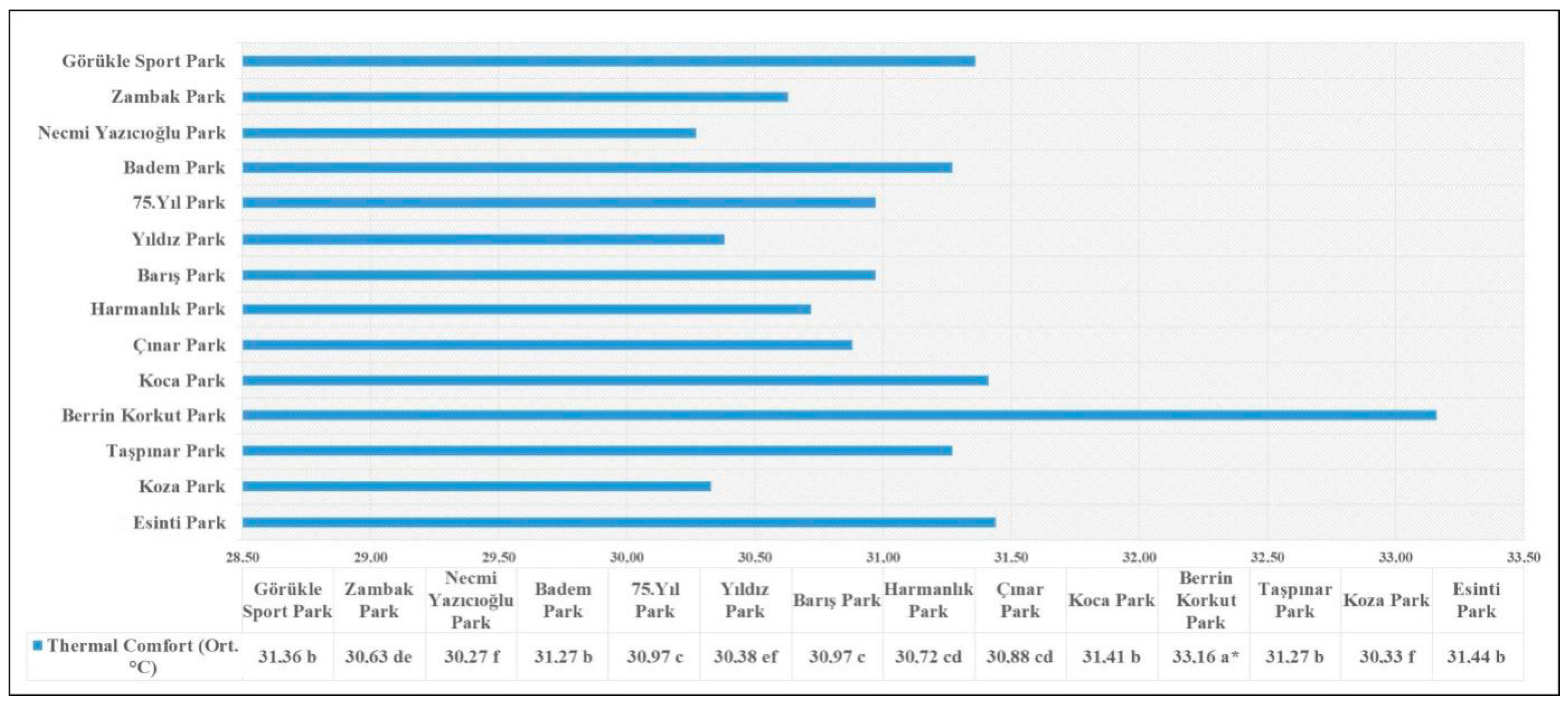
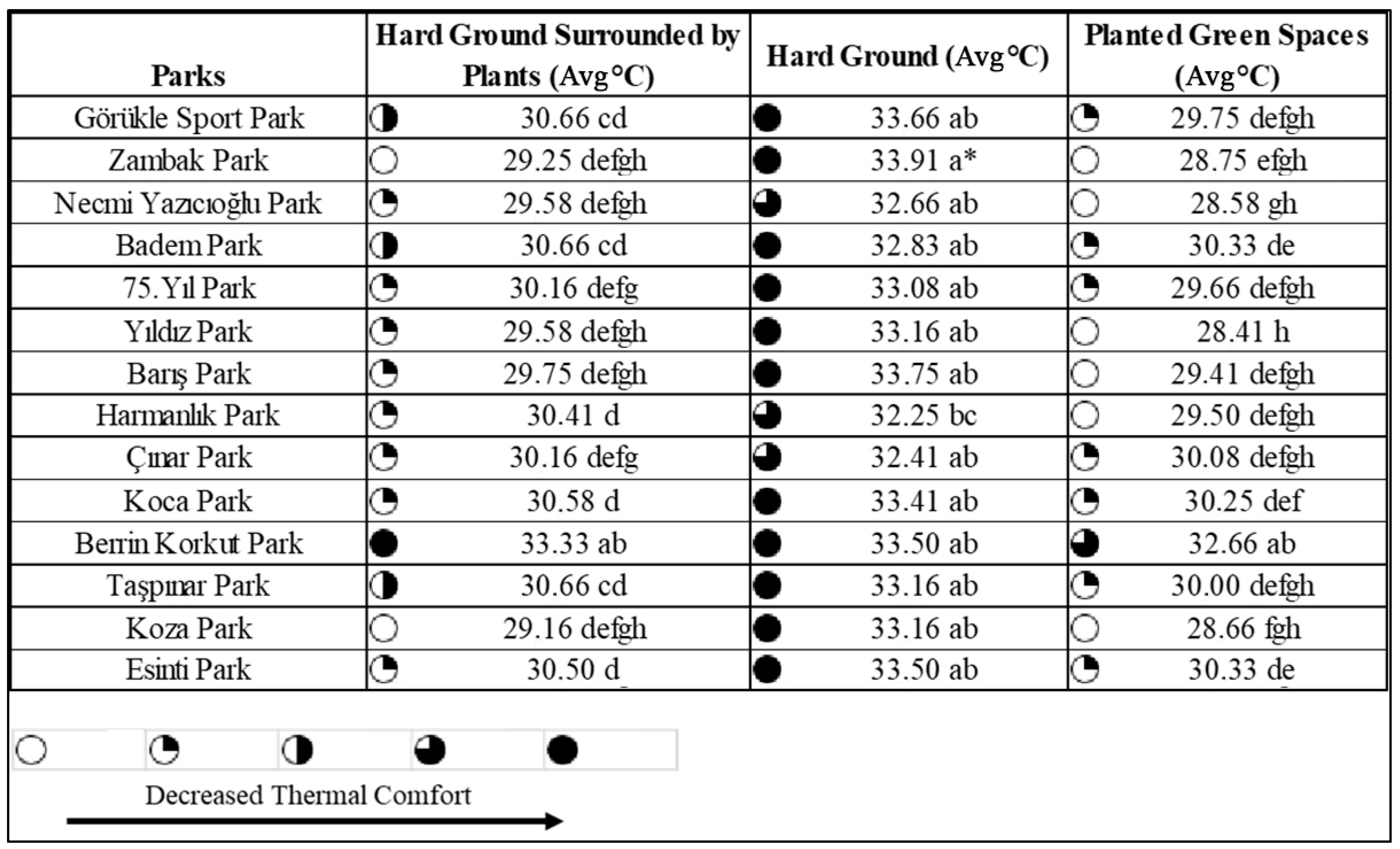
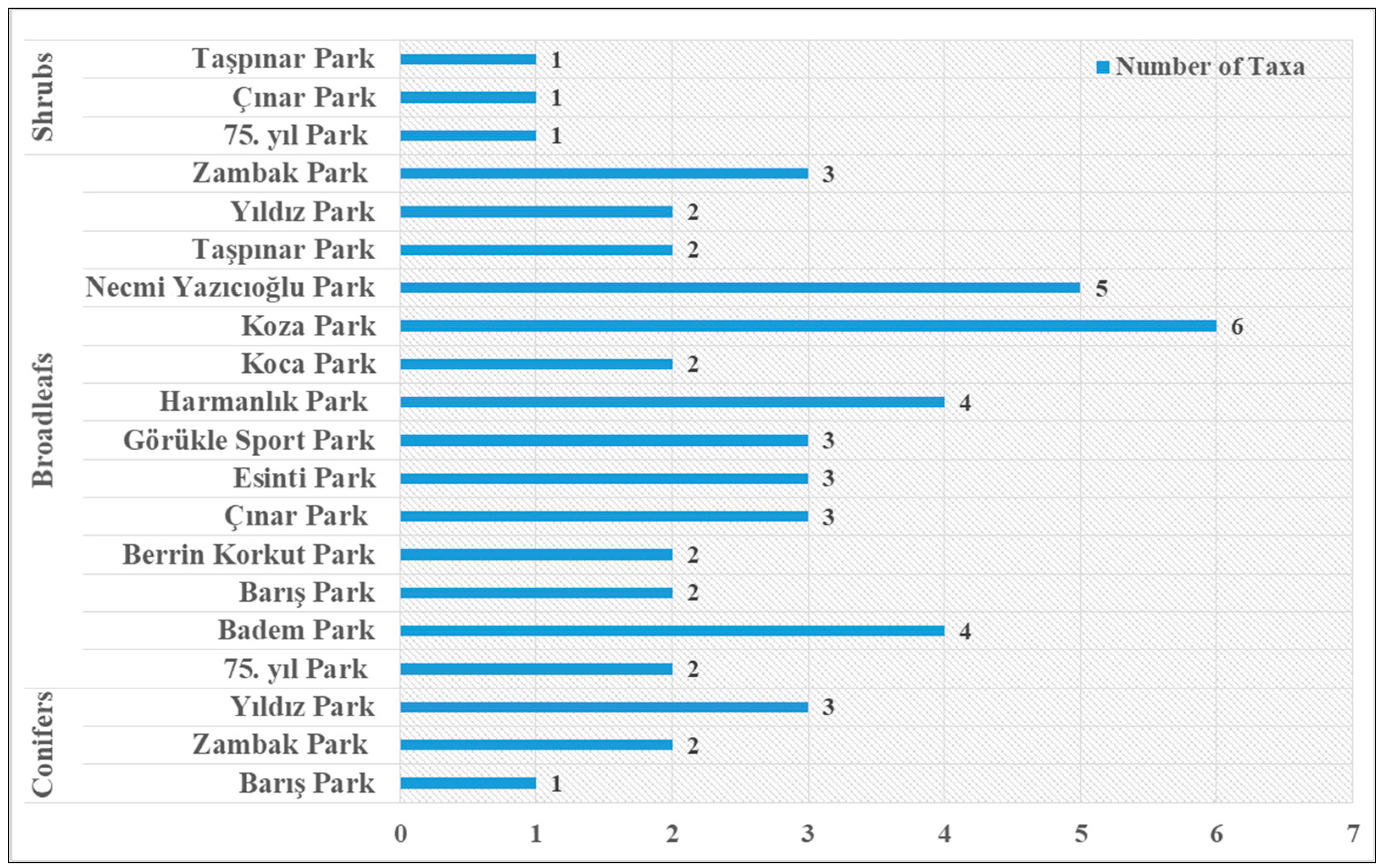
| PMV (°C) | PET (°C) | Human Feeling | Thermal Stress Level |
|---|---|---|---|
| (−3.4)–(−2.5) | 4.1–8.0 | Cold | Strong cold stress |
| (−2.4)–(−1.5) | 8.1–13.0 | Cool | Moderate cold stress |
| (−1.4)–(−0.5) | 13.1–18.0 | Slightly cool | Mild cold stress |
| (−0.4)–0.5 | 18.1–23.0 | Comfortable | No thermal stress |
| 0.6–1.5 | 23.1–29.0 | Mild temperate | Mild heat stress |
| 1.6–2.5 | 29.1–35.0 | Temperate | Moderate heat stress |
| 2.6–3.5 | 35.1–41.0 | Hot | Strong heat stress |
| No | Neighborhood Park Name | Hardscape (m2) | Softscape (m2) | Total Area Size (m2) |
|---|---|---|---|---|
| 1 | Görükle Sport Park | 13,661.71 | 6737.89 | 20,399.60 |
| 2 | Zambak Park | 1837.24 | 873.43 | 2710.67 |
| 3 | Necmi Yazıcıoğlu Park | 358.39 | 780.20 | 1138.59 |
| 4 | Badem Park | 838.77 | 1076.55 | 1915.32 |
| 5 | 75. Yıl Park | 1241.17 | 1735.19 | 2976.36 |
| 6 | Yıldız Park | 870.46 | 2578 | 3448.46 |
| 7 | Barış Park | 759.50 | 1208 | 1967.50 |
| 8 | Harmanlık Park | 582.93 | 990.26 | 1573.19 |
| 9 | Çınar Park | 300 | 774.21 | 1074.21 |
| 10 | Koca Park | 1397.51 | 567.56 | 1965.07 |
| 11 | Berrin Korkut Park | 590 | 9.25 | 599.25 |
| 12 | Taşpınar Park | 1352.03 | 314.45 | 1666.48 |
| 13 | Koza Park | 719 | 1427.81 | 2146.81 |
| 14 | Esinti Park | 1091.40 | 1902.37 | 2993.77 |
| Months | PMV (°C) | PET (°C) | The Felt Temperature | Thermal Stress Level |
|---|---|---|---|---|
| Jan | −7.10 | −2.6 | Gelid | Extreme cold stress |
| Feb | −6.22 | 0.35 | Gelid | Extreme cold stress |
| Mar | −6.81 | 0.58 | Gelid | Extreme cold stress |
| Apr | −2.80 | 6.02 | Cold | Strong cold stress |
| May | −0.72 | 13.8 | Cool | Mild cold stress |
| Jun | 0.25 | 18.20 | In comfort | No thermal stress |
| Jul | 2.3 | 31.17 | Milder | Moderate heat stress |
| Aug | 1.13 | 25.47 | Mild | Mild heat stress |
| Sep | 0.31 | 18.12 | In comfort | No thermal stress |
| Oct | −1.82 | 12.45 | Cool | Moderate cold stress |
| Nov | -3.30 | 7.77 | Cold | Strong cold stress |
| Dec | -4.87 | 1.31 | Gelid | Extreme cold stress |
| Parameters | Temperature (Avg. °C) | |
|---|---|---|
| Month | July | 31.05 |
| August | 31.09 | |
| Significance | n.s. | |
| Day | 10th | 28.89 c |
| 20th | 31.45 b | |
| 30th | 32.89 a* | |
| Measurement location | Hard ground surrounded by plants | 30.32 b |
| Hard ground | 33.17 a* | |
| Planted green spaces | 29.74 c | |
| Significance | * | |
| Temperature (Avg. °C) | ||
|---|---|---|
| M × D | ||
| July | 10. Day | 26.50 e |
| 20. Day | 32.39 b | |
| 30. Day | 34.30 a* | |
| August | 10. Day | 31.28 c |
| 20. Day | 30.52 d | |
| 30. Day | 31.47 c | |
| Significance | * |
| Park | Temperature (Avg. °C) | Total Number of Plants (Pieces) | Taxa |
|---|---|---|---|
| Yıldız Park | 28.41 d | 5 | Pinus pinea Thuja occidentalis Robinia pseudoacacia |
| Necmi Yazıcıoğlu Park | 28.58 bc | 5 | Prunus cerasifera Magnolia grandiflora Acer negundo Pistacia lentiscus |
| Koza Park | 28.66 bc | 6 | Quercus cerris Robinia pseudoacacia Liquidambar orientalis Prunus domestica |
| Zambak Park | 28.75 bc | 5 | Robinia pseudoacacia Juniperus horizontalis |
| Barış Park | 29.41 bc | 4 | Acer negundo Prunus cerasifera Cupressus macrocarpa |
| Harmanlık Park | 29.50 bc | 4 | Robinia pseudoacacia Prunus cerasifera |
| 75.Yıl Park | 29.66 bc | 3 | Ficus carica Euonymus japonica |
| Görükle Sport Park | 29.75 bc | 3 | Robinia pseudoacacia Carpinus betulus |
| Taşpınar Park | 30.00 bc | 3 | Ailanthus altissima Acer platanoides Yucca flamentosa |
| Çınar Park | 30.08 bc | 3 | Populus nigra Euonymus japonica |
| Koca Park | 30.25 bc | 2 | Robinia pseudoacacia Acer negundo |
| Esinti Park | 30.33 b | 3 | Prunus cerasifera Liquidambar orientalis |
| Badem Park | 30.33 b | 4 | Prunus cerasus |
| Berrin Korkut Park | 32.66 a* | 2 | Ailanthus altissima |
Disclaimer/Publisher’s Note: The statements, opinions and data contained in all publications are solely those of the individual author(s) and contributor(s) and not of MDPI and/or the editor(s). MDPI and/or the editor(s) disclaim responsibility for any injury to people or property resulting from any ideas, methods, instructions or products referred to in the content. |
© 2024 by the authors. Licensee MDPI, Basel, Switzerland. This article is an open access article distributed under the terms and conditions of the Creative Commons Attribution (CC BY) license (https://creativecommons.org/licenses/by/4.0/).
Share and Cite
Akarsu Varşak, N.; Ender Altay, E. Thermal Comfort and Green Spaces: The Role of Temperature-Regulating Elements in Neighborhood Parks. Sustainability 2024, 16, 9801. https://doi.org/10.3390/su16229801
Akarsu Varşak N, Ender Altay E. Thermal Comfort and Green Spaces: The Role of Temperature-Regulating Elements in Neighborhood Parks. Sustainability. 2024; 16(22):9801. https://doi.org/10.3390/su16229801
Chicago/Turabian StyleAkarsu Varşak, Nurcan, and Elvan Ender Altay. 2024. "Thermal Comfort and Green Spaces: The Role of Temperature-Regulating Elements in Neighborhood Parks" Sustainability 16, no. 22: 9801. https://doi.org/10.3390/su16229801
APA StyleAkarsu Varşak, N., & Ender Altay, E. (2024). Thermal Comfort and Green Spaces: The Role of Temperature-Regulating Elements in Neighborhood Parks. Sustainability, 16(22), 9801. https://doi.org/10.3390/su16229801






